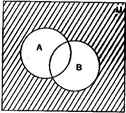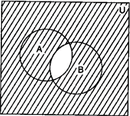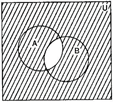Exercise 1.5
1. Let U = {1, 2, 3, 4, 5, 6, 7, 8, 9}, A = {1, 2, 3, 4}, B = {2, 4, 6, 8} and C = {3, 4, 5, 6}. Find:
(i) A’
(ii) B’
(iii) (A  C)’
C)’
(iv) (A  B)’
B)’
(v) (A’)’
(vi) (B – C)’
Ans. Given: U = {1, 2, 3, 4, 5, 6, 7, 8, 9},
A = {1, 2, 3, 4},
B = {2, 4, 6, 8} and C = {3, 4, 5, 6}.
(i) A’ = U – A = {1, 2, 3, 4, 5, 6, 7, 8, 9} – {1, 2, 3, 4}
= {5, 6, 7, 8, 9}
(ii) B’ = U – B = {1, 2, 3, 4, 5, 6, 7, 8, 9} – {2, 4, 6, 8}
= {1, 3, 5, 7, 9}
(iii) (A  C)’ = U – (A
C)’ = U – (A  C)
C)
= {1, 2, 3, 4, 5, 6, 7, 8, 9} – ({1, 2, 3, 4}  {3, 4, 5, 6})
{3, 4, 5, 6})
= {1, 2, 3, 4, 5, 6, 7, 8, 9} – {1, 2, 3, 4, 5, 6} = {7, 8, 9}
(iv) (A  B)’ = U – (A
B)’ = U – (A  B)
B)
= {1, 2, 3, 4, 5, 6, 7, 8, 9} – ({1, 2, 3, 4}  {2, 4, 6, 8})
{2, 4, 6, 8})
= {1, 2, 3, 4, 5, 6, 7, 8, 9} – {1, 2, 3, 4, 6, 8} = {5, 7, 9}
(v) (A’)’ = U – A’ = U – (U – A)
= {1, 2, 3, 4, 5, 6, 7, 8, 9} – ({1, 2, 3, 4, 5, 6, 7, 8, 9} – {1, 2, 3, 4})
= {1, 2, 3, 4, 5, 6, 7, 8, 9} – {5, 6, 7, 8, 9}
= {1, 2, 3, 4} = A
(vi) (B – C)’ = U – (B – C)
= {1, 2, 3, 4, 5, 6, 7, 8, 9} – ({2, 4, 6, 8} – {3, 4, 5, 6})
= {1, 2, 3, 4, 5, 6, 7, 8, 9} – {2, 8}
= {1, 3, 4, 5, 6, 7, 9}
2. If U =  find the complement of the following sets:
find the complement of the following sets:
(i) A = 
(ii) B = 
(iii) C = 
(iv) D = 
Ans. Given: U = 
(i) A’ = U – A
= 
(ii) B’ = U – B
= 
(iii) C’ = U – C
= 
(iv) D’ = U – D
= 
3. Taking the set of natural numbers as the universal set, write down the complement of the following set:
(i) { is an even natural number}
is an even natural number}
(ii) { is an odd natural number}
is an odd natural number}
(iii) { is a positive multiple of 3}
is a positive multiple of 3}
(iv) { is a prime number}
is a prime number}
(v) { is a natural number divisible by 3 and 5}
is a natural number divisible by 3 and 5}
(vi) { is a perfect square}
is a perfect square}
(vii) { is a perfect cube}
is a perfect cube}
(viii) { + 5 = 8}
+ 5 = 8}
(ix) { +5=9}
+5=9}
(x) 
(xi) {
 N and
N and  }
}
Ans. Given: U = 
(i) Let A = { is an even natural number}
is an even natural number}
 A’ = U – A =
A’ = U – A =  – {
– { is an even natural number}
is an even natural number}
= { is an odd natural number}
is an odd natural number}
(ii) Let A = { is an odd natural number}
is an odd natural number}
 A’ = U – A =
A’ = U – A =  – {
– { is an odd natural number}
is an odd natural number}
= { is an even natural number}
is an even natural number}
(iii) Let A = { is a positive multiple of 3}
is a positive multiple of 3}
 A’ = U – A =
A’ = U – A =  – {
– { is a positive multiple of 3}
is a positive multiple of 3}
= {
 is not a positive multiple of 3}
is not a positive multiple of 3}
(iv) Let A = { is a prime number}
is a prime number}
 A’ = U – A =
A’ = U – A =  – {
– { is a prime number}
is a prime number}
= {
 is not a prime number}
is not a prime number}
(v) Let A = { is a natural number divisible by 3 and 5}
is a natural number divisible by 3 and 5}
 A’ = U – A =
A’ = U – A =  – {
– { is a natural number divisible by 15}
is a natural number divisible by 15}
= {
 is not divisible by 15}
is not divisible by 15}
(vi) Let A = { is a perfect square}
is a perfect square}
 A’ = U – A =
A’ = U – A =  – {
– { is a perfect square}
is a perfect square}
= {
 is not a perfect square}
is not a perfect square}
(vii) Let A = { is a perfect cube}
is a perfect cube}
 A’ = U – A =
A’ = U – A =  – {
– { is a perfect cube}
is a perfect cube}
= {
 is not a perfect cube}
is not a perfect cube}
(viii) Let A = { + 5 = 8} = {3}
+ 5 = 8} = {3}
 A’ = U – A =
A’ = U – A =  – {3}
– {3}
= {
 3}
3}
(ix) Let A = { +5=9} = {2}
+5=9} = {2}
 A’ = U – A =
A’ = U – A =  – {2}
– {2}
= {
 2}
2}
(x) Let A =  = {7, 8, 9, 10, ………}
= {7, 8, 9, 10, ………}
 A’ = U – A =
A’ = U – A =  – {7, 8, 9, 10, ………}
– {7, 8, 9, 10, ………}
={1, 2, 3, 4, 5, 6} = {
 7}
7}
(xi) Let A = {
 N and
N and  } = {5, 6, 7, 8, ………..}
} = {5, 6, 7, 8, ………..}
 A’ = U – A =
A’ = U – A =  – {5, 6, 7, 8, ………..}
– {5, 6, 7, 8, ………..}
= {1, 2, 3, 4}
4. If U = {1, 2, 3, 4, 5, 6, 7, 8, 9}, A = {2, 4, 6, 8} and B = {2, 3, 5, 7}, verify that:
(i) 
(ii) 
Ans. Given: U = {1, 2, 3, 4, 5, 6, 7, 8, 9},
A = {2, 4, 6, 8} and B = {2, 3, 5, 7}
(i) L.H.S. =  = U – (A
= U – (A  B)
B)
= {1, 2, 3, 4, 5, 6, 7, 8, 9} – ({2, 4, 6, 8}  {2, 3, 5, 7})
{2, 3, 5, 7})
= {1, 2, 3, 4, 5, 6, 7, 8, 9} – {2, 3, 4, 5, 6, 7, 8} = {1, 9}
R.H.S. =  = (U – A)
= (U – A)  (U – B)
(U – B)
= ({1, 2, 3, 4, 5, 6, 7, 8, 9} – {2, 4, 6, 8})  ({1, 2, 3, 4, 5, 6, 7, 8, 9} – {2, 3, 5, 7})
({1, 2, 3, 4, 5, 6, 7, 8, 9} – {2, 3, 5, 7})
= {1, 3, 5, 7, 9}  {1, 4, 6, 8, 9} = {1, 9}
{1, 4, 6, 8, 9} = {1, 9}
L.H.S. = R. H. S.


(ii) L.H.S. = 
= U – (A  B)
B)
= {1, 2, 3, 4, 5, 6, 7, 8, 9} – ({2, 4, 6, 8}  {2, 3, 5, 7})
{2, 3, 5, 7})
= {1, 2, 3, 4, 5, 6, 7, 8, 9} – {2}
= {1, 3, 4, 5, 6, 7, 8, 9}
R.H.S. =  = (U – A)
= (U – A)  (U – B)
(U – B)
= ({1, 2, 3, 4, 5, 6, 7, 8, 9} – {2, 4, 6, 8})  ({1, 2, 3, 4, 5, 6, 7, 8, 9} – {2, 3, 5, 7})
({1, 2, 3, 4, 5, 6, 7, 8, 9} – {2, 3, 5, 7})
= {1, 3, 5, 7, 9}  {1, 4, 6, 8, 9}
{1, 4, 6, 8, 9}
= {1, 3, 4, 5, 6, 7, 8, 9}
L.H.S. = R. H. S.


5. Draw appropriate Venn diagrams for each of the following:
(i) 
(ii) 
(iii) 
(iv) 
Ans. (i) In the diagrams, shaded portion represents 

(ii) In the diagrams, shaded portion represents 

(iii) In the diagrams, shaded portion represents 

(iv) In the diagrams, shaded portion represents 

6. Let U be the set of all triangles in a plane. If A is the set of all triangles with at least one angle different from  what is A’?
what is A’?
Ans. Given: U = { is a triangle}
is a triangle}
A = { is a triangle and has at least one angle different from
is a triangle and has at least one angle different from  }
}
 A’ = U – A = {
A’ = U – A = { is a triangle and has all angles equal to
is a triangle and has all angles equal to  }
}
= Set of all equilateral triangles
7. Fill in the blanks to make each of the following a true statement:
(i) 
(ii) 
(iii) 
(iv) 
Ans. (i) 
(ii) 
(iii) 
(iv) 

Test Generator
Create question paper PDF and online tests with your own name & logo in minutes.
Create Now
Learn8 App
Practice unlimited questions for Entrance tests & government job exams at ₹99 only
Install Now